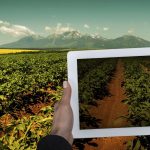 There have been concerns over how to feed the growing global populations since the days of Thomas Malthus, and those concerns have certainly not abated, despite the world being as well fed as at any time in its history.
There have been concerns over how to feed the growing global populations since the days of Thomas Malthus, and those concerns have certainly not abated, despite the world being as well fed as at any time in its history.
Technology is sure to play a part in this, as it has throughout the history of agriculture, but whereas mechanization and biological science has played a huge role in the past, a recent paper argues that data will power the next advances in agriculture.
Data powered agriculture
Indeed, such is the power of data to propel agriculture forward, many companies operating in the sector are shifting their focus towards being platform and data driven, whether it’s the use of drone/satellite data to guide crop management, GPS data to analyze field conditions and data around equipment to ensure optimal efficiency.
As with most innovations however, the deployment of such technologies is far from even, with adoption in developing countries offering tremendous potential for improvement in yield.
The paper describes the three dimensions along which big data is typically described:
- Volume
- Velocity
- Variety
In terms of agriculture, the volume of data is not enough on its own, but rather the ability to analyze the data you have so that useful insights can be harvested.
Likewise, these insights need to be delivered in a timely manner in order to be effective. Often, this means real-time insights are required.
Perhaps nowhere is the challenge greater however, than with the variety of potential data available to farmers. Whilst traditionally this was unduly expensive to capture, this is no longer the case but the challenge moves from collection to analysis.
Central to the exploitation of big data in the developing world is the mobile phone, which is undoubtedly the most versatile sensor in the world. The phone offers farmers access to a huge amount of information, but also allows them to contribute to the data commons.
Open data commons
A possible example of how things are going is provided by the Farmers Business Network, which operates out of Iowa. They operate a co-operative data pool, with each member encouraged to upload their data to the commons, where it is then anonymized and made available to other members of the network. The idea is that by pooling data in this way, everyone will gain from the richer insights made available.
I sense that the successful utilization of big data in farming will depend both on the cost-effectiveness of measurement, and of analysis. Whether it’s the humble mobile phone, or affordable sensors for things such as moisture management, there is a rapidly expanding capacity to measure all aspects of farm management.
The analysis of that data is also a growing area of interest for companies large and small. This includes the big, established companies such as Monsanto and John Deere, but also less well known platforms such as Connected Farms, which is produced by Silicon Valley based company Trimble Navigation.
Such projects are likely to herald an age of data driven, precision farming that will go at least some way to ensuring that the growing global population continues to be fed.